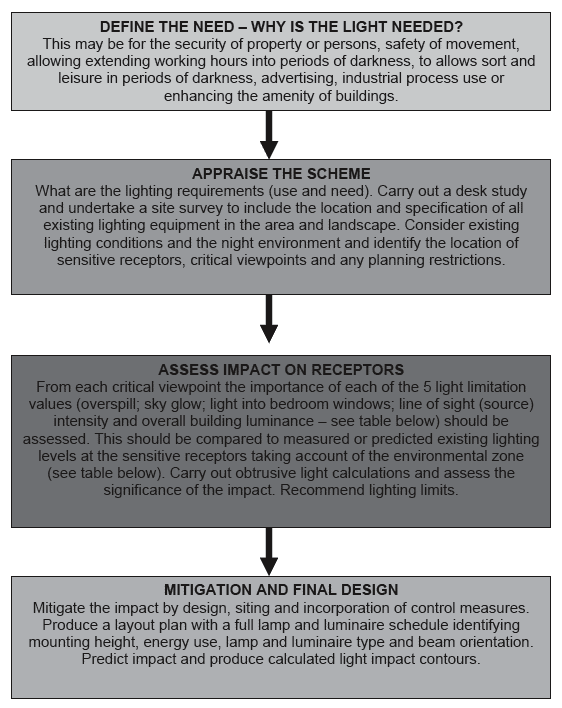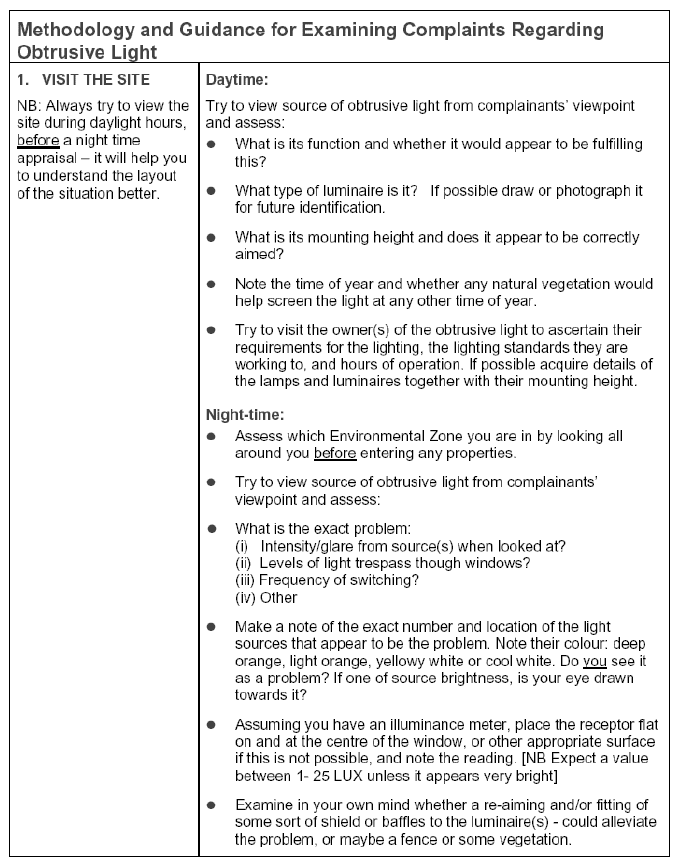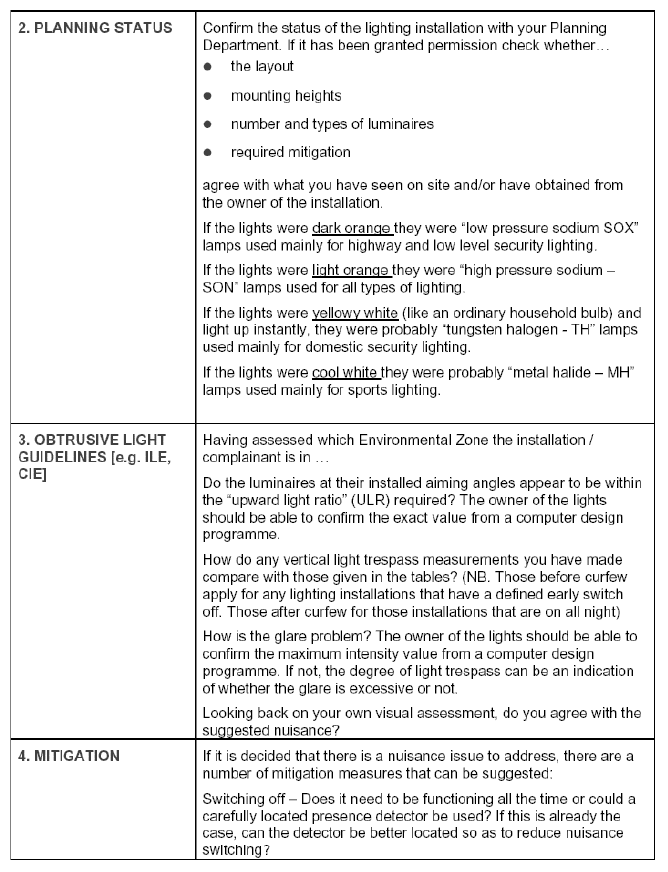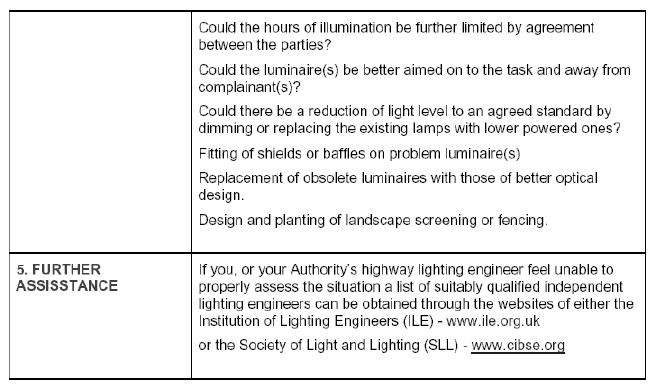Nuisance provisions of the Public Health etc (Scotland) Act 2008: guidance
Procedural guidance on the statutory nuisance provisions outlined in the Public Health etc. (Scotland) Act 2008.
SECTION 2 - EVALUATION OF LIGHTING AND INVESTIGATION OF COMPLAINTS
It should be remembered that the purpose of any lighting installation is to illuminate an area usually by projecting light downwards. It is how this downward light is managed and its effects mitigated and controlled that are important: there will always be a degree of reflected upward light. As a general rule the darker the building or ground cover surfaces are, the lower the upward reflected component and conversely the lighter and wetter the building or ground cover then the higher the upward reflected component will be.
Excessive levels of illuminance and glare due to poorly designed, directed, operated and maintained lighting systems, will cause much artificial light nuisance. The periodic, often deliberate, flickering of light used for advertising can prove to be distracting and like glare, promote degrees of irritation, annoyance and distress. The rate of flicker and the duration of exposure can cause over-stimulation of electrical activity to the human brain. Over exposure to and excessive stimulation by flicker and similar lighting such as strobe lighting has been known to induce attacks in people who suffer with epilepsy or migraine.
The flowsheet in Figure A3.1 below summarises the key steps in undertaking a review of a lighting scheme and some of the key data used for evaluation of lighting schemes referred to in Figure A3.1 is summarised below.
OBTRUSIVE LIGHT CALCULATIONS - Curfew should be taken at 23.00 hours
Environmental Zone
The nationally recognised environmental zones are as follows:
E1: Intrinsically dark Areas - National Scenic Areas
E2: Areas of low district brightness - Rural or small village locations
E3: Areas of medium district brightness - Urban or small town locations
E4: Areas of high district brightness - Large town or city centre with high levels of night time activity
The selected zone should be justified.
Source Intensity
Direct line of sight of the light emitted from luminaires is probably the principal source of obtrusive lighting complaints. This is light radiated directly from the luminaire and the recommended limiting values are:-
| Source Intensity |
E1 |
E2 |
E3 |
E4 |
|---|---|---|---|---|
| Pre Curfew (cd) |
2500 |
7500 |
10000 |
25000 |
| Post curfew (cd) |
0 |
500 |
1000 |
2500 |
Light Intrusion
Light intruding through property windows can be predicted by calculating values on a vertical grid representing a window. The recommended limits are additive to what is already present - these need to be zero if the current levels exceed the limits.
| Intrusion |
E1 |
E2 |
E3 |
E4 |
|---|---|---|---|---|
| Pre Curfew (lux) |
2 |
5 |
10 |
25 |
| Post curfew (lux) |
1 |
1 |
2 |
5 |
Upward Light Ratio
The upward light ratio will vary depending on the tilt angles and light distribution. Many quality luminaires produce a 0% upward light ratio at zero degrees of tilt but will produce an upward light ratio of 2.5% with 10º of tilt. Some luminaires can produce as much as 50% upward light ratio at tilt angles greater than 40º and if this was the case then the lighting installation could be classed as being an obtrusive and inefficient lighting solution.
| Sky Glow |
E1 |
E2 |
E3 |
E4 |
|---|---|---|---|---|
| Upward light ratio |
0% |
2.5% |
5% |
15% |
Glare
The effect of glare, as viewed by an external observer, can be controlled by limiting the viewed source intensity. An additional glare evaluation may be required to protect the interests of road users. spectators and players. Vehicle drivers should not be subjected to a threshold increment level greater than 15% from non-street lighting installations situated adjacent to a public highway.
Building Luminance
Building luminance is normally only carried out for structures which are illuminated. Different surface textures and colours reflect light in different proportions and any luminance calculation should include for a schedule of surface colours and reflection factor characteristics to be assumed in the calculation process.
Combined Effects
The calculation of the combined effects of direct and upward reflected light can be used to demonstrate a comparison between the old and new lighting installation techniques for the difference in upward reflections where new lighting has been designed in conjunction with landscaping techniques that soften their effect by reducing the area allocated to hard landscaping.
The flowsheet below at Figure A3.1 summarises the steps in a lighting design.
Figure A3.1 - Scheme Design

In all cases the investigation of complaints should be a systematic procedure. The following methodology was proposed in a report produced in 2006 for Defra by Temple titled 'Assessment of the Problem of Light Pollution from Security and Decorative Light'.



Contact
Email: Central Enquiries Unit ceu@gov.scot
There is a problem
Thanks for your feedback